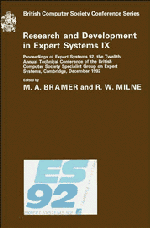Book contents
- Frontmatter
- Contents
- Preface
- Introduction
- CONSULTANT: providing advice for the machine learning toolbox
- A methods model for the integration of KBS and conventional information technology
- KBS methodology as a framework for co-operative working
- Project management for the evolutionary development of expert systems
- The specification and development of rule-based expert systems
- Towards a method for multi-agent system design
- Jigsaw: configuring knowledge acquisition tools
- On the relationship between repertory grid and term subsumption knowledge structures: theory practice tools
- Strategy maze: an on-line tool for support management of the knowledge acquisition process
- Concurrent engineering using collaborating truth maintenance systems
- Ockham's razor as a gardening tool
- A designer's consultant
- Fairness of attribute selection in probabilistic induction
- An application of case-based expert system technology to dynamic job-shop scheduling
- Neural network design via LP
- KEshell2: an intelligent learning data base system
- Approaches to self-explanation and system visibility in the context of application tasks
- An object oriented approach to distributed problem solving
- Intelligent user interface for multiple application systems
- Combining qualitative and quantitative information for temporal reasoning
- Documents as expert systems
Intelligent user interface for multiple application systems
Published online by Cambridge University Press: 04 August 2010
- Frontmatter
- Contents
- Preface
- Introduction
- CONSULTANT: providing advice for the machine learning toolbox
- A methods model for the integration of KBS and conventional information technology
- KBS methodology as a framework for co-operative working
- Project management for the evolutionary development of expert systems
- The specification and development of rule-based expert systems
- Towards a method for multi-agent system design
- Jigsaw: configuring knowledge acquisition tools
- On the relationship between repertory grid and term subsumption knowledge structures: theory practice tools
- Strategy maze: an on-line tool for support management of the knowledge acquisition process
- Concurrent engineering using collaborating truth maintenance systems
- Ockham's razor as a gardening tool
- A designer's consultant
- Fairness of attribute selection in probabilistic induction
- An application of case-based expert system technology to dynamic job-shop scheduling
- Neural network design via LP
- KEshell2: an intelligent learning data base system
- Approaches to self-explanation and system visibility in the context of application tasks
- An object oriented approach to distributed problem solving
- Intelligent user interface for multiple application systems
- Combining qualitative and quantitative information for temporal reasoning
- Documents as expert systems
Summary
Abstract: Current intelligent user interfaces have two limitations: (i) They are domain specific and mainly built for existing database management systems, (ii) They are specific to the target systems for which they are constructed. However, user goals, which motivate interactions with a computer, are likely to be complicated and to require the use of multiple target systems in various domains. In this paper, we discuss the development of intelligent user interfaces which are not subject to the limitations identified. An architecture is proposed, the major function of which is the dynamic integration and intelligent use of multiple target systems relevant to a user's goals. Other important features of the proposed system include its theoretical orientation around relevance relationships, mental models and speech acts, and the introduction of “system experts” and “goal manager”. A prototype Intelligent Multifunctional User Interface, (IMUI), is briefly described which indicates that the proposed architecture is viable, the methodology is promising, and the theoretical ideas introduced are worthy of further investigation.
INTRODUCTION
Computer-based systems are coming to play an ever more important part in our society, and as they do so, they become increasingly complicated and difficult to use effectively. As a consequence, the need to develop flexible and versatile intelligent interfaces has become more crucial than ever.
What would an ideal interface look like, and how can such a system be designed and implemented? Most investigators would agree that it should behave like an intelligent human assistant who has expert knowledge both of user characteristics and requirements, and of target system(s).
- Type
- Chapter
- Information
- Research and Development in Expert Systems IX , pp. 301 - 316Publisher: Cambridge University PressPrint publication year: 1993
- 1
- Cited by

